What is it?
Renault’s much anticipated compact SUV, the Kiger, is here. Built on the Renault-Nissan Alliance’s CMF-A+ platform that also underpins the Triber and the Magnite, the Kiger made its international debut in India recently, underlining the importance of the model and our market to the French carmaker.
Based on a 2,500mm wheelbase, the Kiger measures 3,991mm in length and 1,750mm in width, which is the narrowest for any compact SUV. However, what does help its cause is the large chrome-embellished front grille and the sculpted bonnet that makes it appear wider than it is. The Kiger gets a split-headlamp arrangement with the LED DRLs and turn indicators positioned on top and the main headlamp cluster located below. On top trims, the headlights are all-LED units that are housed in three separate projector units. There’s also a liberal use of black plastic on the front bumper which provides good contrast. You wouldn’t be alone to see the Kiger as an XL-sized Kwid, but on the whole it’s an attractive looker.
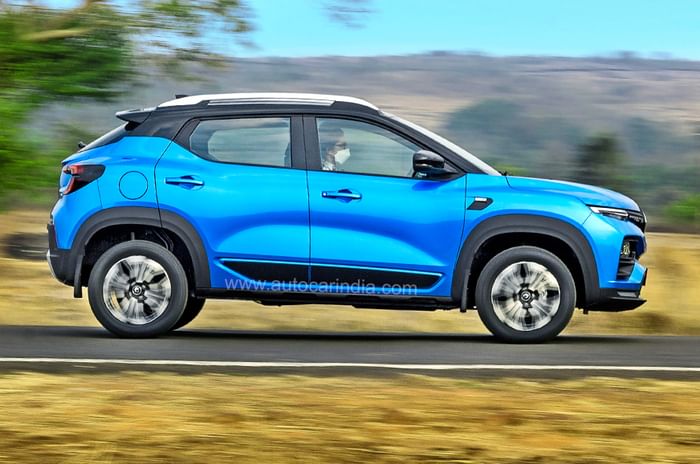
Renault didn't want to go for a typical boxy SUV look with the Kiger, which is apparent by its raked rear windscreen, tapering roofline and distinct spoiler element, all of which lends it a SUV-coupe-like profile. The standout feature at the back are the 3D, C-shaped LED tail-lamps with gloss black elements. The boot lid too has plenty of cuts and creases and it also has a chunky rear bumper, body cladding and a faux skid plate. What completes the SUV look is the 205mm of ground clearance, the roof rails which can take loads up to 50 kg and the smart 16-inch diamond-cut alloys.
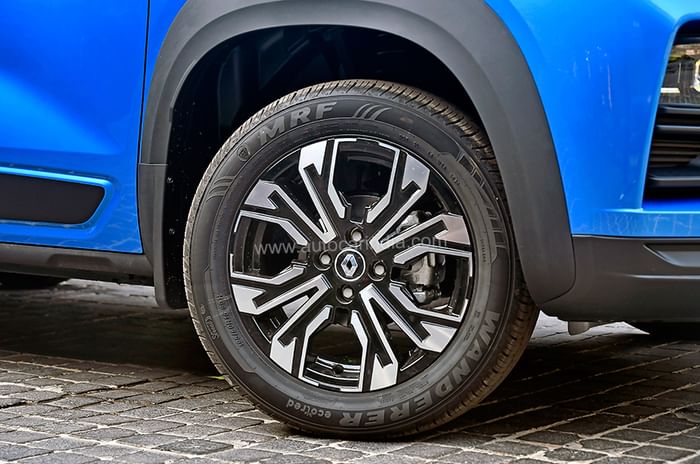
The Renault Kiger can be had in 6 exterior colours, with a dual-tone paint scheme available across the entire variant line-up. This particular colour on our test car, Caspian Blue, looked decidedly awesome under the Goan sunshine.
What’s it like on the inside?
Step inside the Kiger and you’re greeted with a neat dashboard, one that is similar in design to that of the Triber’s. An all-new 8-inch touchscreen, that’s slick enough in its operation, takes centre stage on the dash. What really is a boon is the wireless integration for Apple CarPlay and Android Auto. In its top trims, the Kiger is also equipped with a high-res, 7-inch digital instrument cluster that displays really cool graphics depending on the drive mode you’re in, which we’ll get to in a bit.
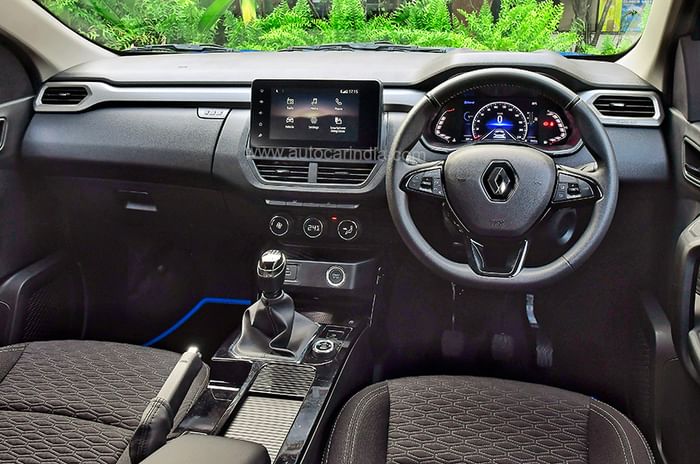
You won’t find any soft touch materials on the dash but plastic quality is more than acceptable for the Kiger’s price. Renault has also done a good job to spruce up the cabin with chrome detailing around the gear lever, piano black elements on the centre console and the climate control knobs with integrated readouts (shared with the Magnite) look premium too. However, there’s no escaping that costs have been cut in order to price the Kiger so competitively. For example, elements like the internal rear- view mirror, sun shades and roof lining feel very basic.
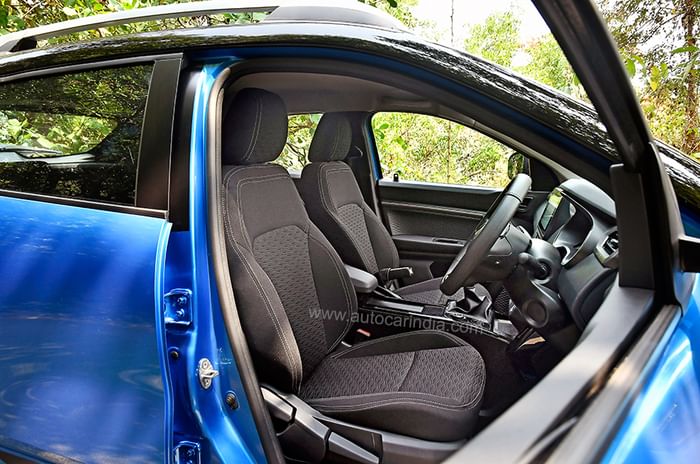
Up front, it is easy to find a comfortable driving position and you get a good view out of the cabin. The seats themselves are supportive, well-bolstered and have a cool pattern on them. One of the highlights on the Kiger, though, is the space on offer for rear seat passengers. Headroom and legroom at the rear are both great and the flat floor also makes life easier for the middle passenger. The fold-down armrest is also well positioned, and if anything, it’s that the rear windows are a bit small.
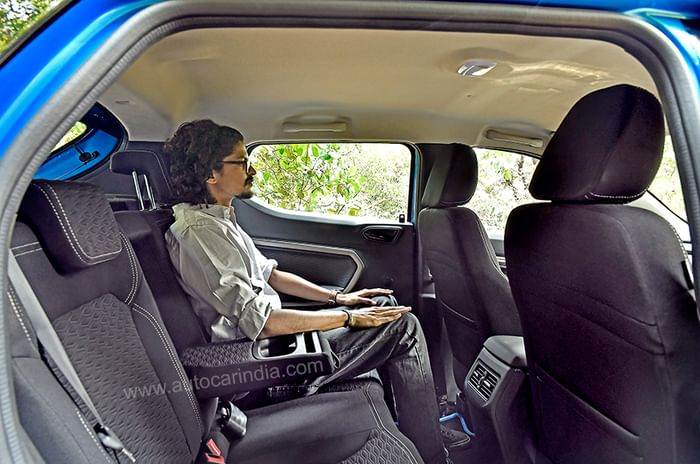
The Kiger is one of the most practical SUVs in the segment, with lots of storage space inside the cabin. This is thanks to practical and large storage spaces like the twin gloveboxes and the cental storage space between the elbow box and the gear lever.) The Kiger also impresses with a class-leading 405 litre boot. The combination of a high loading lip and low boot floor do make loading heavy luggage difficult. However, Renault will offer an accessory shelf that makes the boot floor level with the opening. There’s also the added flexibility of 60:40 split rear seats.
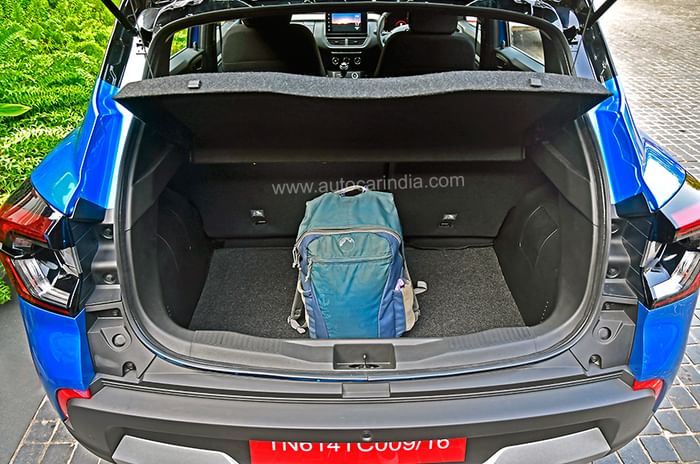
On the equipment front, the range-topping Kiger RXZ has an Arkamys 3D sound system, keyless entry-go, automatic climate control with PM 2.5 filter, ambient lighting, cooled glove box and power folding mirrors, though the all-important sunroof is missing and there are a few blank switches on the steering wheel, presumably for a cruise control that could be added on a future update. A wireless charger and an external air purifier can be had as part of an accessory pack. Safety features include four airbags, ABS with EBD, ISOFIX child-seat mounts, a rear-view camera and parking sensors.
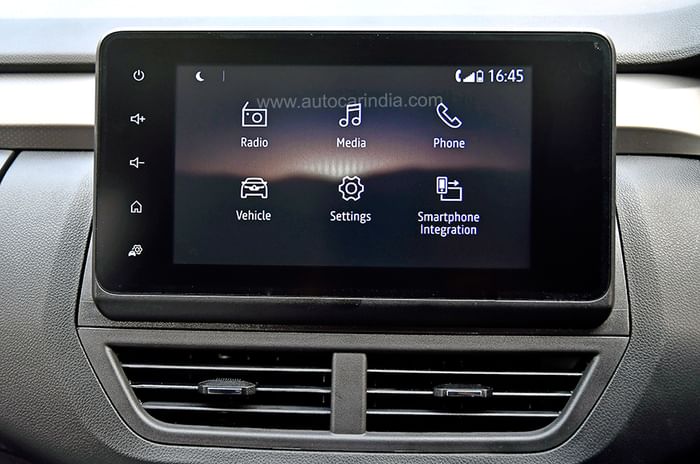
What’s it like to drive?
Powering the Kiger are two, three-cylinder 1.0-litre petrol engines. There’s a naturally aspirated unit that puts out 72hp and 96Nm of torque and can be had with either a 5-speed manual or an AMT gearbox. This engine also does duty in the Renault Triber. The other engine option is the new HR10 turbo-petrol engine that made it’s debut on the Nissan Magnite and will find its way into a number of Renault-Nissan Alliance products in the future. The unit produces 100hp and 160Nm of torque with a 5-speed manual gearbox and 152Nm when paired to a CVT automatic. Renault expects the automatic variants to make up 30 percent of sales. Just like in the Magnite, there’s no diesel option with the Kiger, nor will there ever be as the CMF-A+ platform simply cannot accommodate one. We got to sample the Kiger turbo-petrol manual on our drive in Goa.
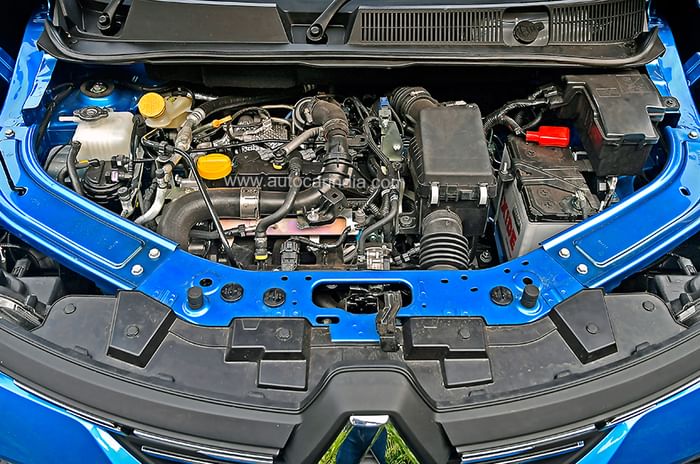
Thumb the starter button in the centre console and the engine comes to life, settling into a silent idle. While the engine is relatively quiet, you do feel some of the three-pot motor’s vibrations in the cabin, namely on the steering wheel and gear lever.
However, once you set off, the engine feels smoother and builds speed with confidence even when its off-boost. The boost comes in at around 1,700rpm, but it does so without any prominent surge or spike, as is common with turbocharged engines. Performance stays strong until past 5,000rpm, after which it tapers off, though you can wind the engine to 6,500rpm. Revving hard makes the engine sound quite loud and there’s no missing that three-cylinder thrum either. The turbo-petrol Kiger responds keenly to quick taps on the accelerator, which makes for easy overtaking or quickly filling gaps in traffic. It has decent low-range grunt too, but like other small capacity turbo-petrol engine-powered cars you’ll need to be mindful to be in the right gear on climbs. On the subject, the Kiger’s 5-speed manual gearbox has long throws and takes a bit of effort to slot into the gates but, it is precise enough. The clutch pedal however, is light and easy to modulate.

A major talking point on the Kiger is the inclusion of three driving modes – Normal, Eco and Sports. These modes are controlled via a rotary dial on the centre console and they alter the Kiger’s throttle response and steering. These modes do make a noticeable difference to the Kiger’s performance, with the car feeling most responsive in Sports mode. The digital dashboard also displays cool graphics when in Sports, such as power and torque usage and even a G-meter. Normal mode put the emphasis on the speed display while Eco highlights the rpm band for most efficient driving.
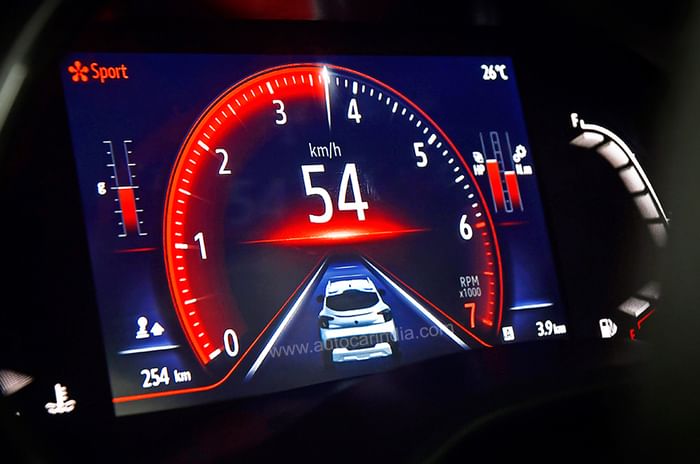
Goa’s winding and twisty roads also gave us a chance to test out the Kiger’s handling capabilities. The Kiger has good body control and there’s a good amount of grip on offer too, making it quite capable in the bends. The Renault turns with confidence and the Sport mode that adds noticeable weight to the steering only helps the experience. The steering is also light at low speeds but it requires one too many twirls lock-to-lock, which is something you’ll note when parking. That being said, the Kiger is an easy car to place and feels at home in tight city confines. In terms of braking, there’s a lack of an initial bite after which the Kiger decelerates in linear and progressive manner.
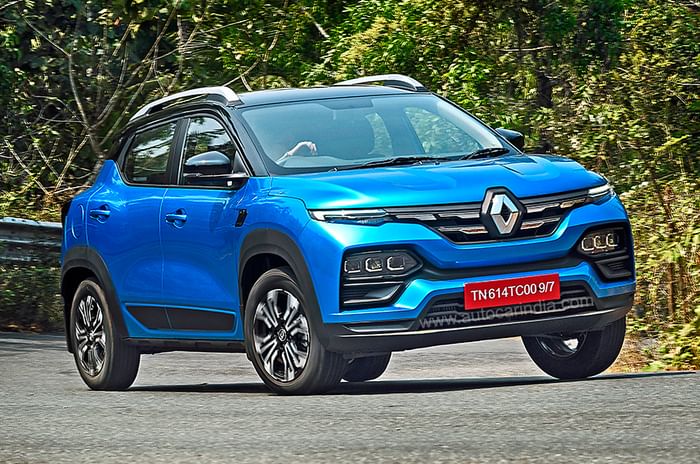
Also impressive is the Kiger’s ride quality. There is an underlying firmness to the ride but it’s not to the point of being jarring, and on really bad patches, it actually feels quite tightly screwed together, almost like a mini-Duster. The big surprise is how the Kiger feels at cruising speeds. Body movements are well contained and it feels more surefooted than its 1 tonne weight would suggest. It drives like a bigger and heavier car and that’s a big compliment to the Renault. Where the Kiger feels quite average is in refinement levels. There’s plenty of road, tyre and wind noise in the cabin at high speeds and you can even hear the suspension hard at work.
Should I buy one?
Priced from Rs 5.45 lakh (ex-showroom, pan-India), the Kiger officially becomes the most affordable compact SUV, just about undercutting its Nissan sibling, the Magnite. While Nissan may have had the first mover advantage within the Alliance with the Magnite; by taking a few months longer, Renault seemed to have made the Kiger a more rounded package.
What you get for your money is a comfortable compact SUV that’s great to look at, good to drive and decently equipped with features as well. Sure, the Kiger does miss out on some features that are now common in its class, like a sunroof, cruise control and connected car technology and Renault has also visibly saved costs in places, but factor in its price, Rs 8.55 lakh for the top-spec RXZ turbo-petrol manual that we drove, and you can really see the value in this proposition.
Not only does it undercut the entire compact SUV segment and almost create a sub-segment, the Renault Kiger in this top-spec form is more affordable than even some premium hatchbacks like the new Hyundai i20. If the demand for the Magnite is anything to go by, which garnered 32,000 bookings within a month from its launch, and considering the value-for-money it offers buyers, the Renault Kiger could just become the next big thing in the compact SUV segment.







































